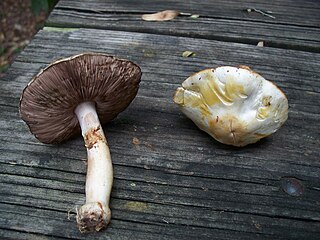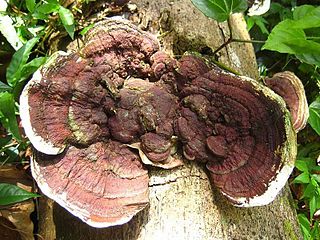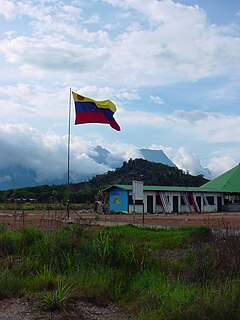Related Research Articles

John Torrey was an American botanist, chemist, and physician. Throughout much of his career, he was a teacher of chemistry, often at multiple universities, while he also pursued botanical work, focusing on the flora of North America. His most renowned works include studies of the New York flora, the Mexican Boundary, the Pacific railroad surveys, and the uncompleted Flora of North America.

Barthélemy Charles Joseph Dumortier was a Belgian who conducted a parallel career of botanist and Member of Parliament.
Lambia is a genus of green algae in the family Bryopsidaceae.

The Polyporaceae are a family of poroid fungi belonging to the Basidiomycota. The flesh of their fruit bodies varies from soft to very tough. Most members of this family have their hymenium in vertical pores on the underside of the caps, but some of them have gills or gill-like structures. Many species are brackets, but others have a definite stipe – for example, Polyporus badius.
Hoverter and Sholl Box Huckleberry Natural Area is a 10-acre (4.0 ha) natural area in Perry County, Pennsylvania, near New Bloomfield, which protects a colony of box huckleberry over 1,000 years old. The smallest Natural Area in Pennsylvania, it is administered as part of Tuscarora State Forest. It was designated a National Natural Landmark in April 1967.

Agaricus abruptibulbus is a species of mushroom in the genus Agaricus. It is commonly known as the abruptly-bulbous agaricus or the flat-bulb mushroom. First described by the mycologist Charles Horton Peck, this bulbous-stemmed edible species smells slightly of anise, and turns yellow when bruised or cut. The mushroom is medium-sized, with a white, yellow-staining cap on a slender stipe that has a wide, flat bulb on the base
Emiliania is a global coccolithophorid genus.
Duboscquella is a genus of dinoflagellates.

Earliella is a fungal genus in the family Polyporaceae. It is a monotypic genus, containing the single species Earliella scabrosa. It is found in Hainan.

Elizabeth Gertrude Britton was an American botanist, bryologist, and educator. She and her husband, Nathaniel Lord Britton played a significant role in the fundraising and creation of the New York Botanical Garden. She was a co-founder of the predecessor to the American Bryological and Lichenological Society. She was an activist for protection of wildflowers, inspiring local chapter activities and the passage of legislation. Elizabeth Britton made major contributions to the literature of mosses, publishing 170 papers in that field.

Cerro Duida, named Yennamadi by the ye'kwana, is a very large tepui in Amazonas state, Venezuela. It has an uneven and heavily inclined plateau, rising from highs of around 1,300–1,400 metres (4,300–4,600 ft) in the north and east to a maximum of 2,358 metres (7,736 ft) on its southwestern rim. It has a summit area of 1,089 km2 (420 sq mi) and an estimated slope area of 715 km2 (276 sq mi). At its foot lies the small settlement of La Esmeralda, from which the mountain can be climbed.

Anna Murray Vail was an American botanist and first librarian of the New York Botanical Garden. She was a student of the Columbia University botanist and geologist Nathaniel Lord Britton, with whom she helped to found the New York Botanical Garden.
Vailia is a monotypic genus of flowering plants belonging to the family Apocynaceae. It just contains one species, Vailia mucronataRusby
Margaret Hannah Fulford was an American bryologist who was active in identifying the flora of North and South America. The standard author abbreviation Fulford is used to indicate this person as the author when citing a botanical name.

George Newton Best was an American bryologist, expert on moss taxonomy, and second president of the Sullivant Moss Society.
Polyclita is a monotypic genus of flowering plants belonging to the family Ericaceae. It only contains one known species, Polyclita turbinata(Kuntze) A.C.Sm.
Tateanthus is a monotypic genus of flowering plants belonging to the family Melastomataceae. It only contains one known species, Tateanthus duidaeGleason
Rusbya is a monotypic genus of flowering plants belonging to the family Ericaceae. It only contains one known species, Rusbya taxifoliaBritton
Killipia is a genus of flowering plants belonging to the family Melastomataceae. It is now a 'synonym' of MiconiaRuiz & Pav..
Ochoterenaea is a monotypic genus of flowering plants belonging to the family Anacardiaceae. The only species is Ochoterenaea colombiana.
References
- ↑ Kirk PM, Cannon PF, Minter DW, Stalpers JA (2008). Dictionary of the Fungi (10th ed.). Wallingford, UK: CABI. p. 45. ISBN 978-0-85199-826-8.
- ↑ Embree RW, Indoh H (1967). "Aquamortierella, a new genus in the Mucorales". Bulletin of the Torrey Botanical Club. 94 (6): 464–7. doi:10.2307/2483563. JSTOR 2483563.
- ↑ Burkhardt, Lotte (2022). Eine Enzyklopädie zu eponymischen Pflanzennamen [Encyclopedia of eponymic plant names](pdf) (in German). Berlin: Botanic Garden and Botanical Museum, Freie Universität Berlin. doi:10.3372/epolist2022. ISBN 978-3-946292-41-8. S2CID 246307410 . Retrieved January 27, 2022.